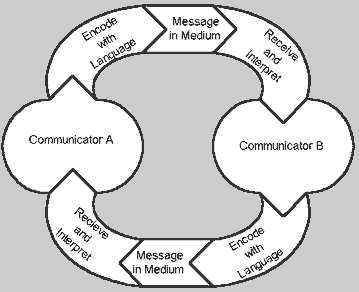Understanding Communication
A basic definition of communication is: “the process of creating and sharing meaning through the use of symbols.”
Communication models have been proposed to help us understand what is going on in that process. The Interactive and Trasactional Communication Models help us understand the processes of human communication extensively. These models go beyond those developed in the past, in that they include, "the concepts of noise and feedback: each communicator becomes both the source and the receiver of messages and every component of communication becomes susceptible to disruption."



“I know that you believe you understand what you think I said, but I am not sure you realize that what you heard is not what I meant!” That's how difficult communication is.
The fact is that a linguistic utterance can never convey all of a speaker’s intended meaning. At best, a linguistic utterance is a sketch and the listener must fill in the sketch by inferring the meaning from such things as body language, shared knowledge, tone of voice, and so on. Humans must, therefore, be able to infer meanings in order to communicate fully.
Six Simple Steps To Minimize Problems
1. Be clear-- Unless you are direct, neither your clients nor your coworkers will be able to understand you, and it will be difficult for them to accomplish any of your expectations.
2. Get to the point--Your audience will be more likely to focus on your words if they know you are not inclined to wander off onto unhelpful tangents.
3. Be personal-- Let your communication take your audience’s concerns into account.
4. Listen-- You have to be willing to listen as well as to speak.
5. Think before you speak-- If you rush into words, you cannot avoid misunderstandings or saying something you might later regret.
6. Don’t be overly negative-- You can destroy a person's desire to achieve or assist.
Contact Tel : 2517 3225